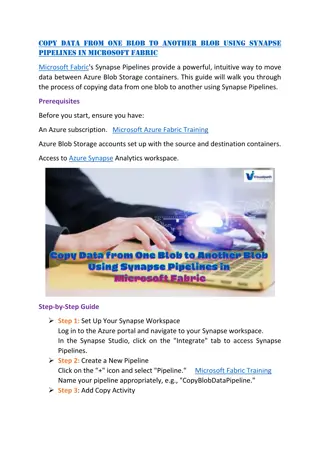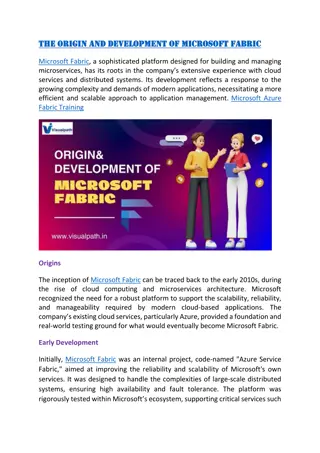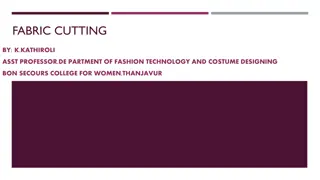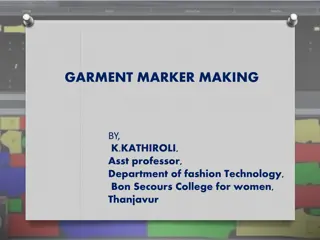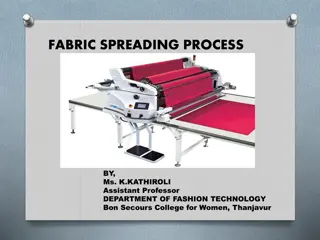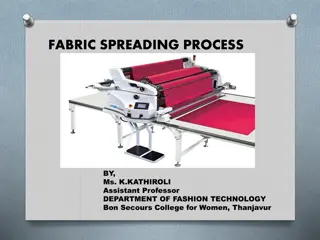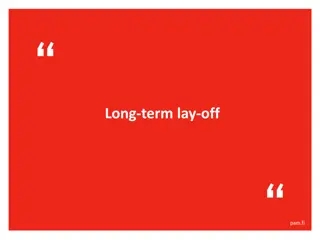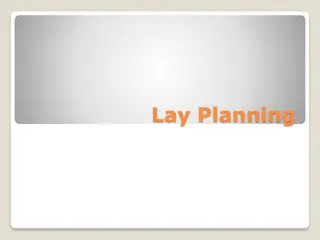Understanding Lay Planning for Efficient Fabric Cutting in Fashion Design
Lay planning is a crucial process in the fashion industry that involves arranging cutting rooms, table spaces, and labor efficiently to optimize fabric spreading and cutting schedules. By effectively managing these resources, production costs can be reduced, fabric wastage minimized, and cutting processes completed on time. Different types of pattern layouts, such as open layout, lengthwise centre fold, and off-centre lengthwise fold, offer various methods for organizing patterns on fabrics to achieve optimal efficiency in garment production.
Download Presentation

Please find below an Image/Link to download the presentation.
The content on the website is provided AS IS for your information and personal use only. It may not be sold, licensed, or shared on other websites without obtaining consent from the author. Download presentation by click this link. If you encounter any issues during the download, it is possible that the publisher has removed the file from their server.
E N D
Presentation Transcript
*Types of Pattern layouts S.SUGANTHI M.Sc., M.Phil. ASSISTANT PROFESSOR DEPARTMENT OF FASHION TECHNOLOGY BON SCOURS COLLEGE FOR WOMEN THANJAVUR
What is lay planning? Lay planning is the arrangement process of cutting room ,table space and labor. Perfect fabric spreading and cutting schedules are depends on the table length, type of equipment, spread length, spreading time, cutting time and personnel. The cutting room manager must maintain the time; properly utilize the equipments, table space, and personnel also.
Why is lay planning important To get a clear managing process of cutting room. To reduce production cost To save the fabric wastage. To finish the cutting process in schedule time. To achieve optimal efficiency. To make the plan easy, computer software can be used. Time consuming. Lay plan is used to cut stripes, checks, border prints, placement prints and laces fabric easily.
Types of Pattern Layouts Based upon the place-ment of the patterns, the layouts are classified as Open layout. Lengthwise centre fold. Off-centre length wise fold. Crosswise outer fold. Off centre crosswise fold. Double fold or combination fold.
OPEN LAYOUT Open layout is the simplest layout. The fabric is spread on the table and the patterns are laid from left to right one after the other. This is easy for beginners. No fold is made in this method. It can be used for all patterns. This is used especially for designs with dif-ferent left and right patterns
LENGTHWISE CENTRE FOLD The fabric is folded in the lengthwise direction. The selvedges of both sides are placed one on top of the other and folded in the middle. The fabric forms a fold at the centre. All folded patterns are placed along this fold. This fold is also used for different type of frocks, shirts and blouses.
OFF-CENTRE LENGTHWISE FOLD The required width needed for the pat-terns is taken on the fabric and folded in the lengthwise direction. This is com-monly seen when many small patterns are found in garments. The fold should be parallel to the selvedge. This is used for many garments from simple baby s panty to integrated men s coats
CROSSWISE CENTER FOLD Crosswise centre fold is similar to length-wise centre fold. In this fold, the fabric is folded in crosswise direction. It is best suited, when the patterns are too narrow to be fitted in the lengthwise fold This fold can also be used when special effects are needed like having a dress with hori- zontal strips using a material with length-wise stripes.
OFF CENTRE CROSSWISE FOLD The off centre crosswise fold is a layout when the fabric is folded in the cross grain. The fold is perpendicular to the selvedge. This fold is used when a part of garment is cut in cross wise grain for ease or spe-cial effects. Example when collars or yokes are cut on fabrics with horizontal strips or vertical strips.
DOUBLE FOLD This is used when many pattern pieces that are not too wide must be cut on fold for garments with no opening for front and back sections. his type of fold can be used provided the cloth is wide enough to accommodate the pattern
COMBINATION FOLD In combination fold the fabric is folded in lengthwise and crosswise grains together. This layout is used for sari petticoats and jablas











